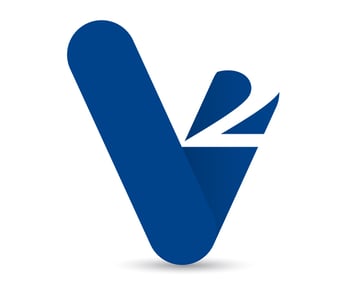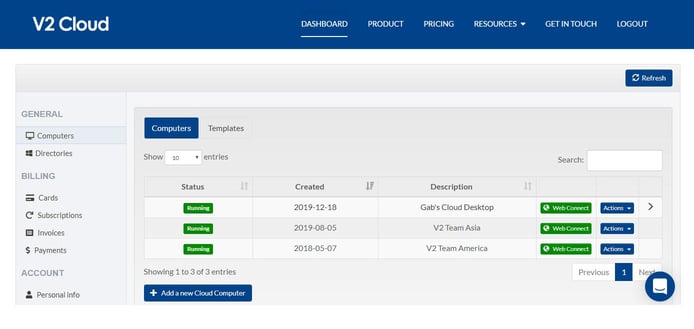
TL; DR: V2 Cloud’s line of virtual cloud desktops offers businesses advantages in speed and security compared to provisioning hardware machines. That is particularly noticeable as remote-work requirements arising from the COVID-19 pandemic make asset management more challenging. The potential ROI from a cloud desktop covers typical IT cost savings, but V2 Cloud also mitigates the complexity of converting applications to different platforms. With distributed workforces becoming the new normal, a centrally managed virtual desktop environment streamlines infrastructure and reduces financial and compliance risks.
The COVID-19 pandemic has proven disruptive, and not in the way that tech innovators often embrace. Instead, the demands of social distancing and various prohibitions against large indoor gatherings have forced companies in industries of all sizes to accommodate remote-work options. The pandemic prompted many companies to try remote work for the first time, often without preparation, and the estimate of work-from-home employees in April jumped from 31% to 62% in just three weeks.
However, for Gabriel Bujold, Chief Marketing Officer of V2 Cloud, remote work is nothing new.
“I’m in Quebec city, but I have colleagues in Macedonia, Pakistan, the United States, and the majority of our team is distributed across Canada,” he said.

V2 Cloud helps businesses run efficient, powerful remote work environments.
V2 Cloud’s support team spans several countries and has always embraced a distributed workforce, which is a key focus for a company that develops and hosts virtual desktop management tools to facilitate remote teams.
According to Gabriel, V2 Cloud is the best way to supercharge a work computer. And it’s a great way to introduce small businesses, developers, and independent software vendors to the world of cloud computing with fully integrated cloud desktop hosting.
Cloud desktops also open support avenues that are more difficult when IT staff lack access to the hardware.
“For COVID-19, a lot of businesses have suddenly become remote,” Gabriel said, citing a more than 560% increase in interest in V2 Cloud’s services in the early months of 2020.
Managed desktops can produce a favorable ROI with an easy-to-manage backend, and limited need to service physical hardware. They will likely outlast any pandemic restrictions and become a normal part of business operations.
Virtual Desktops Offer Advantages in Speed and Security
“I’ve been a digital nomad in the past,” Gabriel said, noting that he’d often take a very low-powered machine into the field — sometimes with as little as 4GB of system memory. But V2 Cloud is much better than the majority of laptops, he said. Whether someone travels around the world or just wants a bit of versatility, it fits their needs.
A high-performance virtual desktop solution transforms computers that may struggle with even routine operating-system tasks into computing powerhouses. With five team-based and four individual plans, V2 Cloud scales virtual computing resources efficiently. It supports configurations as straightforward as two CPU cores and 4GB of memory to resource-rich setups powered by 16 cores and 64GB of memory.
Through V2 Cloud’s low-resource app or a browser session, a user budget laptop could still stream a high-powered desktop environment and obtain all the performance benefits of its higher-end hardware.
“We wanted to push ourselves as a disruptor of the classic PC world where you buy a tower computer for everyone and one person uses 20% of the resources versus developers,” Gabriel said. “Instead of spending $2,000 for a computer, you can pay with a subscription that will just meet your needs.”
That disruption includes V2 Cloud’s soon-to-be-released update that has a fully online model in a zero-client deployment.
A virtual desktop offers significant security benefits, too. Not only does V2 Cloud manage the hosting environment, including virus scanning, but a virtual solution is less prone to ransomware risks or compliance breaches arising from lost or stolen laptops. All the data remains on the server, streamed to the local machine like a movie or a video game.
“You can access V2 Cloud with your browser, a desktop app, or a mobile app,” Gabriel said. The company currently offers mobile apps for Android and iOS. That portability means that employees can access a persistent virtual desktop on any platform without the risk that data on a physical hard drive will become corrupt or compromised.
Businesses Can Improve ROI by Migrating to Cloud-Based Solutions
Flexible plans attuned to specific resource requirements allow companies to provide a targeted computing environment to their workforces that reflect each user’s needs. An intern on the finance team, for example, may need a very basic setup, whereas a developer or a statistician benefits from significantly more computing power. Deploying the right resources to the right people at the right time cuts waste associated with one-size-fits-all hardware that’s overkill for the intern and underpowered for the developer.
Beyond individual computers, however, a comprehensive cloud-hosted desktop solution offers a scalable return on investment in offloading IT support to the cloud hosting vendor.
“Some companies prefer to set things up on their own and manage everything,” Gabriel said. “But I really think, for some enterprises or a small business, if you don’t have an IT department but want to scale, I think we’re a great option for you.”
In other words, using a subscription virtual desktop service significantly mitigates the size and cost of a workforce of desktop support technicians, IT engineers, and analysts necessary to manage assets, networks, and related infrastructure.

V2 Cloud can help businesses reduce expenses, increase security, and quickly see ROI.
“We have one client that runs a CPA firm,” he said. “And the guy is tech-savvy. So his office is 100% on the cloud. They still go to the office, but they’re using a cloud desktop.”
Independent software vendors benefit, too. A virtual desktop makes for a potentially more elegant solution for ISVs than porting and managing applications on a variety of operating systems. “We have a large number of clients that are ISVs,” Gabriel said. “They don’t have the resources to start coding and developing a conversion, especially for something like CAD software. So we use our VMs to provide conversion for these clients.”
V2 Cloud got its start owing to the pains of software development. Gabriel noted that the company’s founder, Mathieu Ferland, grew frustrated at a previous job when he tried to demo software for potential clients, but the hardware itself got in the way of the sales pitch.
“He went to Best Buy and bought a laptop,” Gabriel said. “The problem was, the computer was still slow, and because of that, their software was slow as well. They weren’t able to reflect the impact and performance they wanted.”
Later, Mathieu began work on early forms of streaming desktops to solve this type of problem — and from that experiment, V2 Cloud was born.
Simplicity and Support for the Distributed Workforce of Tomorrow
V2 Cloud’s one-click deployment makes desktop provisioning a breeze, but it still prioritizes its tech-support team.
“Big companies are willing to set up their own cloud infrastructure with certified in-house IT staff,” Gabriel said. “But I truly believe, that for a lot of businesses, it should be possible to scale and benefit from the Cloud without an IT department—I think we’re a great option for those organizations. ”
By removing the underlying complexity from desktop provisioning, V2 Cloud’s service portfolio is ideal even for business owners who don’t see themselves as tech-savvy. “I”m not from an IT background,” Gabriel said, “but I’m able to manage my own computer.”
That simplicity-and-support ethos also applies to pricing. V2 Cloud offers a single all-in price that’s not tied to usage, and both the pricing model and the tech specs for each tier of service are available on the company’s website. Transparent pricing helps entrepreneurs and ISVs perform their own return-on-investment math to determine how the cost of a subscription package weighs against the cost of hardware and the personnel to maintain it.
With the new normal in the post-pandemic world focused on remote work, it’s unlikely that the business community will ever revert to the status quo, and many of the coping strategies they deployed in haste will likely mature and remain a part of the new normal.
With V2 Cloud’s forthcoming zero-client solution, the typical friction points of running a remote desktop have been substantially reduced. That makes it more attractive to companies, and even solo entrepreneurs, who want a solution that just works.
“We are certainly not here just for a short term,” Gabriel said. “We think long term on this. Our team is growing fast, our numbers are growing fast, and a new generation of technologies is coming up.”
HostingAdvice.com is a free online resource that offers valuable content and comparison services to users. To keep this resource 100% free, we receive compensation from many of the offers listed on the site. Along with key review factors, this compensation may impact how and where products appear across the site (including, for example, the order in which they appear). HostingAdvice.com does not include the entire universe of available offers. Editorial opinions expressed on the site are strictly our own and are not provided, endorsed, or approved by advertisers.
Our site is committed to publishing independent, accurate content guided by strict editorial guidelines. Before articles and reviews are published on our site, they undergo a thorough review process performed by a team of independent editors and subject-matter experts to ensure the content’s accuracy, timeliness, and impartiality. Our editorial team is separate and independent of our site’s advertisers, and the opinions they express on our site are their own. To read more about our team members and their editorial backgrounds, please visit our site’s About page.



